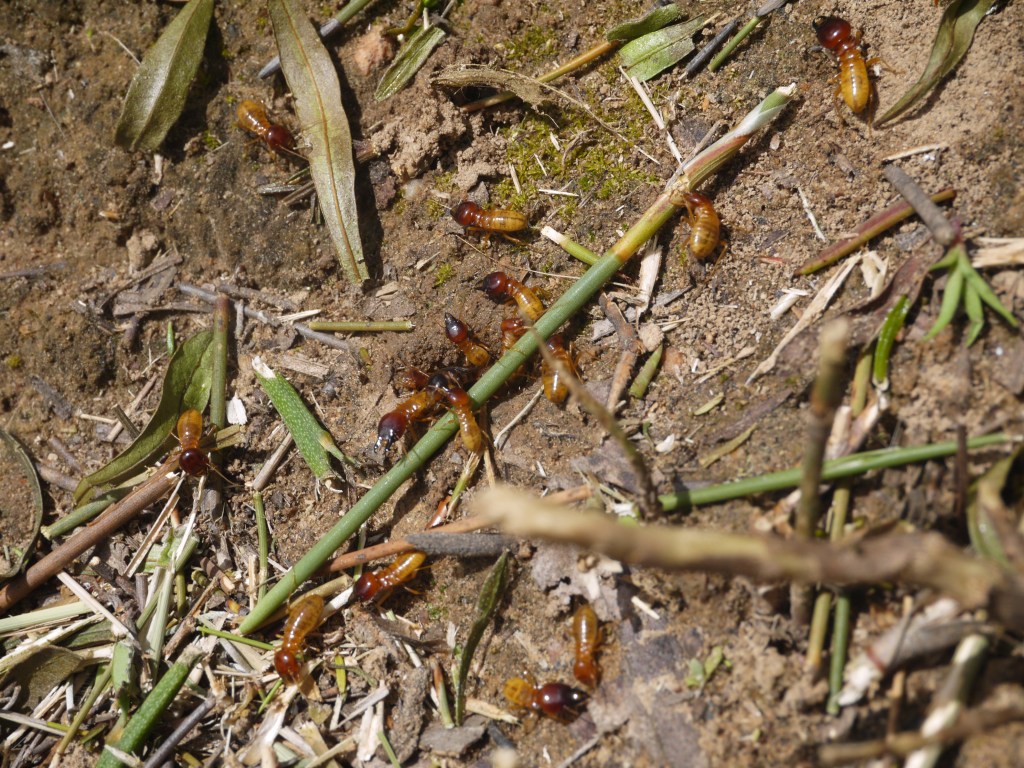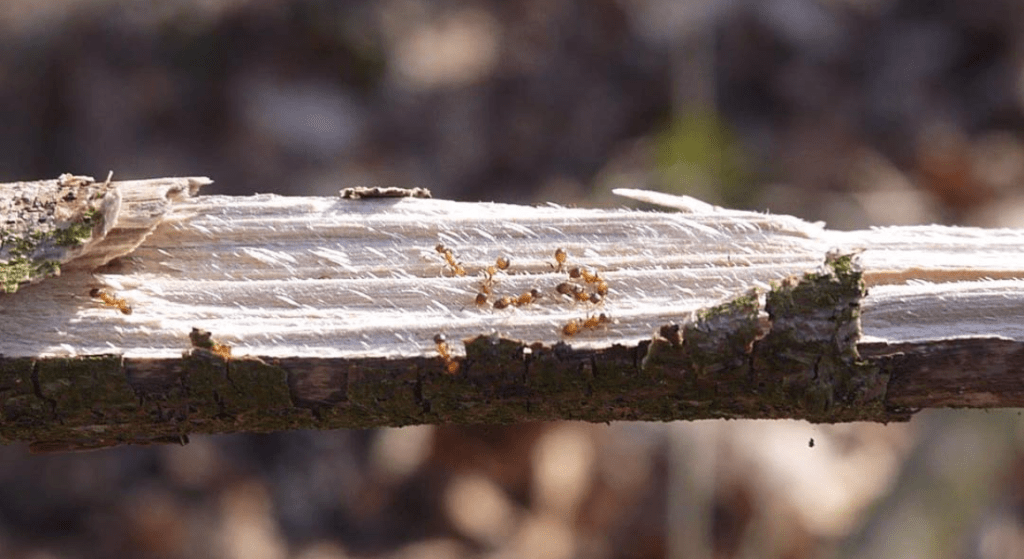Damien will take over the position from Daniela Römer in spring 2024
IS: Who are you, and what do you do?
DG: Hello! I am Damien Gergonne, born in Toulouse, in France, and I am a postdoctoral researcher at the University of Stellenbosch in South Africa. I am interested in evolutionary biology of social insects. I did my PhD on the phylogeography of some Neotropical termites. I am currently working on the invasion dynamics of the invasive wasp Vespula germanica. I also have a couple of parallel projects on termites that I have not given up on, and on the evolution of eusociality, a topic I am passionate about. I am also a musician in my spare time.
Damien Gergonne, a postdoctoral researcher at the University of Stellenbosch, focuses on evolutionary biology of social insects. His current work centers on the invasion dynamics of Vespula germanica wasps.

At the end of Damien’s doctoral defense, with his supervisors. From left to right: Chantal Poteaux, Virginie Roy, Damien Gergonne and David Sillam-Dussès.
IS: How did you develop an interest in your research?
DG: Ever since I first observed some Messor ants in my childhood garden and Crematogaster climbing walls, I have always been interested in social insects (without knowing the name at the time, of course!). Much later, at the University of Toulouse, I did my first internship in a laboratory, and that is where it all really began. The people you work with have a huge influence on the passion and interest you develop over time. I was lucky enough to do my first internship with Enikő Csata and Audrey Dussutour. They helped me get my foot up the ladder. Within a few months I understood that research is very demanding, but above all exciting, and that was it, I wanted to work on social insects.
IS: What is your favorite social insect, and why?
DG: I do not wish to make enemies. I appreciate all social insects, and I am in favor of ending this amusing rivalry between Hymenoptera and termites (although it is important to remember that termites evolved toward eusociality before any other insects).

Damien under the rain in Peru in 2022
IS: What is the best moment/discovery in your research so far? What made it so memorable?
DG: From my modest experience, I think the day my first article was accepted for publication. It was the happiest day of my life. The end of a long and winding road where my endurance was severely tested. I opened the window to express my joy by shouting. The neighborhood didn’t understand what happened but at least they did not call the police. One of my favorite moments, too, was the first time I went in the South American rainforest. A childhood dream come true!

An Embiratermes neotenicus nest in the Peruvian rainforest.
IS: What made you interested in becoming the next social media editor of Insectes Sociaux?
DG: Social insects are fascinating in so many ways. However, when I mention that I’m working on social insects, I sometimes forget to specify what they are, and I realize that not everyone knows. I thought it was important to highlight them. Also, on a more personal note, I think that when we are working on a specific topic, we all tend to get our heads stuck in our own research topic. For me, becoming the next social media editor will be a way to maintain a general overview of social insect research and to meet other researchers.
IS: What ideas do you have to develop the social media presence of Insectes Sociaux?
DG: I will probably work on creating more stories, more polished visual content with some explanations that are accessible to the general audience. The blogs will continue and I will look for a way to highlight them a bit more. I am open to any ideas you might have.
IS: Do you teach or do outreach/science communication? How do you incorporate your research into these areas?
DG: Apart from a few scientific conferences, I am not involved in much communication or teaching now, since I finished my PhD in 2023. However, I was lucky enough to participate in “Ma thèse en 180 secondes” a few years ago. I had to present my work in 3 minutes to a non-specialist audience. It’s a very enriching experience that helps improve your ability to synthesize information and speak to the general audience. I would advise any PhD student to try it if it exists in their country.
IS: What do you think are some of the important current questions in social insect research, and what is essential for future research?
DG:There are many. For me, one of the big questions is the emergence of eusociality in insects, and why it occurs in groups as far apart as termites and ants, for example. There is a lot of research going on, but there is still so much to understand. What’s more, there is still a lot to be learned about the dispersal of these insects at different temporal and geographic scales. The study of dispersal has many uses. For example, it can help us understand how vulnerable and ecologically important species respond to changes in habitat. In the case of invasive species, it can also help us understand the factors that limit invasions. On larger geographic and temporal scales, it shows how these insects have evolved.

Microhodotermes viator in activity, close to Stellenbosch, in South Africa.
IS: Outside of science, what are your favorite activities, hobbies, or sports?
DG: Music, especially punk rock music. I play in a band called Little Havana and we are currently working on our new album. It is like submitting an article. It is a long process of creativity, rigor, and you have to have fun doing it. All the members of the band are like co-authors of the album and we have to get it right. And stick to the plan. I also recently fell in love with boxing. Doing science all day and then going to the club to fight is something I really enjoy, although I still get punched in the face too often…

Little Havana performing at Toulouse at L’Engrenage in 2023. From left to right: Max, Damien, Félix (behind, at the drums), and Yuk (cred: Mélodie De Radvan).
IS: What is the last book you read? Would you recommend it? Why or why not?
DG: I have just finished “La vie de fourmis / La vie des termites” by the belgian author Maurice Maeterlinck. Despite the sometimes overly anthropomorphic reflections and the accusations of plagiarism that have surrounded a part of his writings, the book remains a pleasant and interesting read. With a critical mind, it is not unpleasant to deviate a little from scientific reality with a little more poetry. However, I think there are books that are more relevant if you are interested in social insects, as some of the information is outdated.
IS: How do you keep going when things get tough?
DG: When I was in France, rehearsing with my band or doing a punk rock show was a great way to take my mind off things and use up my energy. It helped me to take my mind off things and come back to work with a new motivation. Now that I am in South Africa, I still play music, but I use my energy mostly through sports. It does not matter how bad a day I have had, a quick workout can help me regain control of my life. Something important too: since I have been in South Africa, I have been calling friends and family more, which helps.
IS: If you were to go live on an uninhabited island and could only bring three things, what would you bring? Why?
DG: A guitar to keep me from getting bored, my binoculars, and a bird guide to the island in question, because it is important to know who my neighbors are.
IS: Who do you think has had the most considerable influence on your science career?
DG: My career is still too short to have the necessary hindsight to pick just one person! All my supervisors, from my first internship to my PhD, have passed on their passion to me, but they have also taught me to be more rigorous and, above all, helped me to make important decisions and sacrifices. I have been fortunate to meet great people who I have stayed in touch with. I can also mention Greg Graffin. He is the leader of a punk rock band and a professor at the University of California at Los Angeles. By reading his books and listening to his music, I understood that I could do science and music at the same time, and I also understood the punk side of doing science. Sometimes you have to accept and defend ideas that are contrary to those that are implanted in the popular mind.
IS: What advice would you give to someone hoping to be a social insect researcher in the future?
DG: Do not choose a study model too quickly, choose a big question. I do not think you should have a vision that is limited to one particular study model, but rather that you should be open to the possibility of changing models, as I was when I went from ants to termites, and then from termites to wasps. But it’s important to have a guiding question, a kind of thread that runs through the research. That question can be very broad, but it will be refined and take different directions over time and as opportunities arise.

Temnothorax crassispinus, found at the University of Regensburg, in Germany, in 2019. Nests can be found by breaking off small branches.
IS: Has learning from a mistake ever led you to success?
DG: I have no particular example, but of course I make a lot of mistakes, many of which I fortunately no longer make. And others that stay with me. Little by little I try to get better at doing science. I still listen to people who are more experienced.

In the Colombian tropical forest, sampling some Embiratermes chagresi termites in 2022.
IS: What is your favorite place science has taken you?
DG: In 2022, we were collecting termites in the Colombian forest in the hinterland not far from Buenaventura. The political climate had thrown the country into a kind of turmoil, so we were stuck in a forest station for a few days, with orders not to leave until the narcos and armed groups had reopened the roads. It is stupid, but I was happy at the time, because my only problem in life was how to avoid this goat that attacked me as soon as I left my cabin (it literally followed me to kill me), but otherwise I experienced it as a sweet vacation in the middle of nowhere… I will always remember this place.

The devil goat.

The view from the Centro Forestal Tropical Pedro Antonio Pineda, in Colombia.
